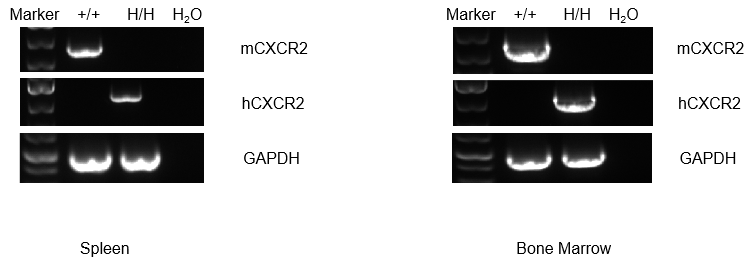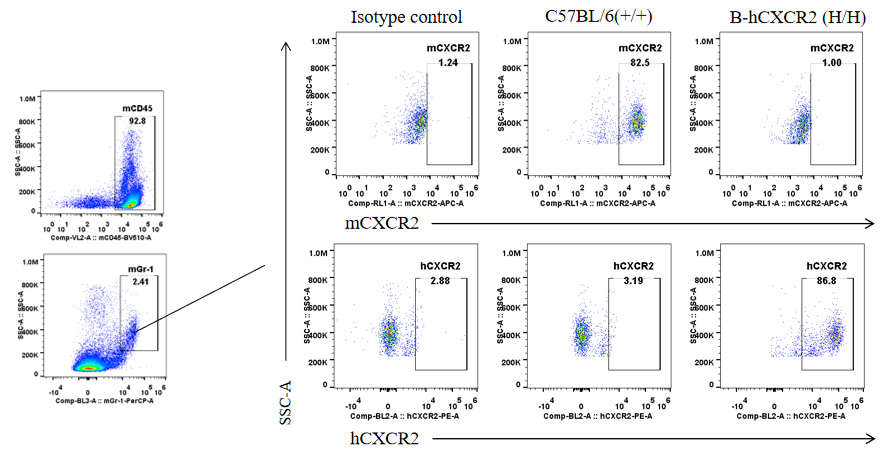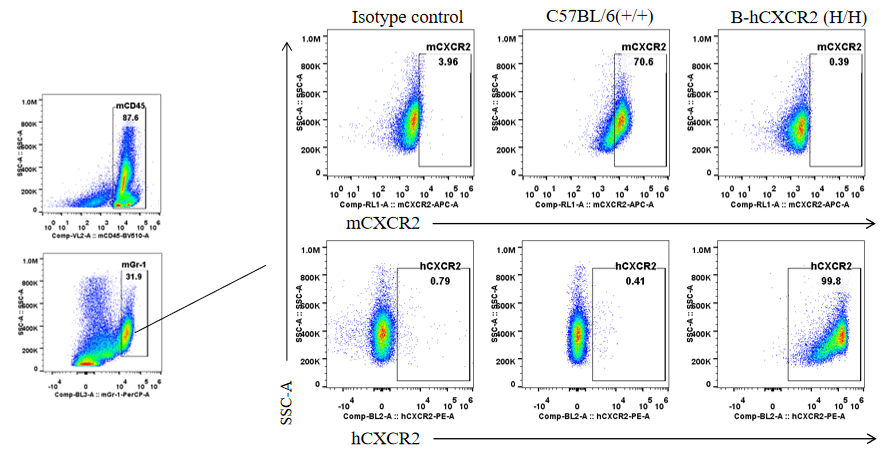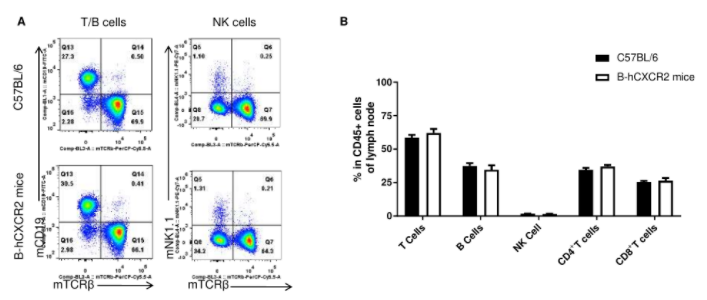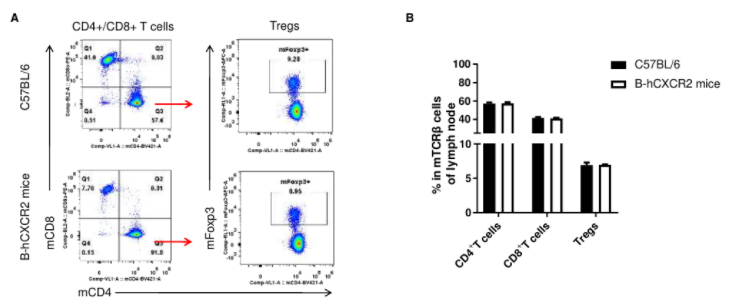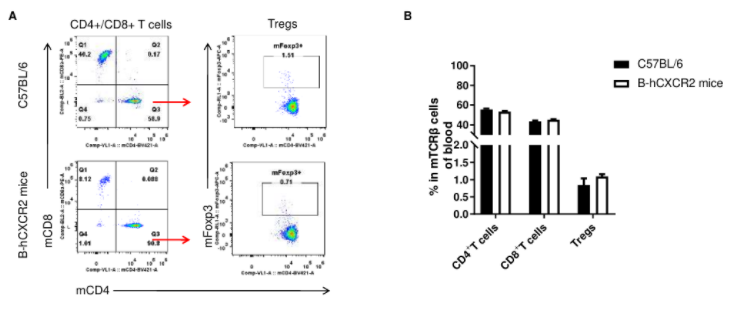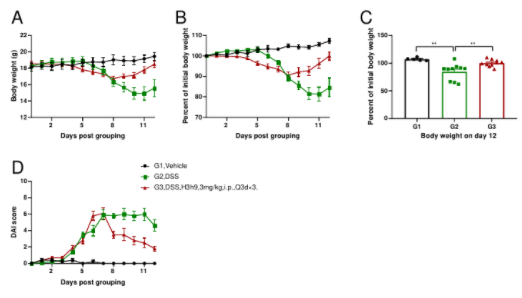mRNA expression analysis
Strain specific analysis of CXCR2 gene expression in WT and B-hCXCR2 mice by RT-PCR. Mouse Cxcr2 mRNA was detectable in spleen and bone marrow of wild-type (+/+) mice. Human CXCR2 mRNA was detectable only in H/H, but not in +/+ mice.
Protein expression analysis in Gr-1+ cells in spleen
Strain specific CXCR2 expression analysis in homozygous B-hCXCR2 mice by flow cytometry. Splenocytes were collected from WT and homozygous B-hCXCR2 (H/H) mice, and analyzed by flow cytometry with species-specific CXCR2 antibody. Mouse CXCR2 was detectable in WT mice. Human CXCR2 was exclusively detectable in homozygous B-hCXCR2 but not WT mice.
Protein expression analysis in Gr-1+ cells in bone marrow
Strain specific CXCR2 expression analysis in homozygous B-hCXCR2 mice by flow cytometry. Bone marrow was collected from WT and homozygous B-hCXCR2 (H/H) mice, and analyzed by flow cytometry with species-specific CXCR2 antibody. Mouse CXCR2 was detectable in WT mice. Human CXCR2 was exclusively detectable in homozygous B-hCXCR2 but not WT mice.
Analysis of T cell subpopulation in spleen
Analysis of spleen leukocyte subpopulations by FACS. Splenocytes were isolated from female C57BL/6 and B-hCXCR2 mice (n=3, 7-week-old). Flow cytometry analysis of the splenocytes was performed to assess leukocyte subpopulations. A. Representative FACS plots. Single live cells were gated for the CD45+ population and used for further analysis as indicated here. B. Results of FACS analysis. Percent of T cells, B cells, NK cells, dendritic cells, granulocytes, monocytes and macrophages in homozygous B-hCXCR2 mice were similar to those in the C57BL/6 mice, demonstrating that CXCR2 humanized does not change the overall development, differentiation or distribution of these cell types in spleen. Values are expressed as mean ± SEM.
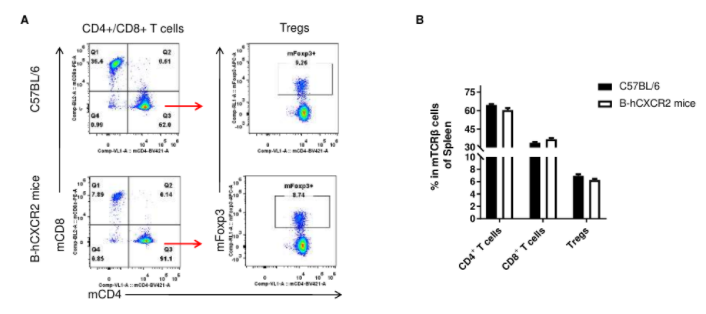
Analysis of spleen T cell subpopulations by FACS. Splenocytes were isolated from female C57BL/6 and B-hCXCR2 mice (n=3, 7-week-old). Flow cytometry analysis of the splenocytes was performed to assess leukocyte subpopulations. A. Representative FACS plots. Single live CD45+ cells were gated for TCRβ+ T cell population and used for further analysis as indicated here. B. Results of FACS analysis. The percent of CD4+ T cells, CD8+ T cells and Tregs in homozygous B-hCXCR2 mice were similar to those in the C57BL/6 mice, demonstrating that introduction of hCXCR2 in place of its mouse counterpart does not change the overall development, differentiation or distribution of these T cell subtypes in spleen. Values are expressed as mean ± SEM.
Analysis of leukocytes cell subpopulation in lymph node(LNs)
Analysis of LNs leukocyte subpopulations by FACS. LNs were isolated from female C57BL/6 and B-hCXCR2 mice (n=3, 7-week-old). Flow cytometry analysis of the LNs was performed to assess leukocyte subpopulations. A. Representative FACS plots. Single live cells were gated for the CD45+ population and used for further analysis as indicated here. B. Results of FACS analysis. Percent of T cells, B cells and NK cells in homozygous B-hCXCR2 mice were similar to those in the C57BL/6 mice, demonstrating that CXCR2 humanized does not change the overall development, differentiation or distribution of these cell types in LNs. Values are expressed as mean ± SEM.
Analysis of T cell subpopulation in lymph node(LNs)
Analysis of LNs T cell subpopulations by FACS. LNs were isolated from female C57BL/6 and B-hCXCR2 mice (n=3, 7-week-old). Flow cytometry analysis of the LNs was performed to assess leukocyte subpopulations. A. Representative FACS plots. Single live CD45+ cells were gated for TCRβ+ T cell population and used for further analysis as indicated here. B. Results of FACS analysis. The percent of CD4+ T cells, CD8+ T cells and Tregs in homozygous B-hCXCR2 mice were similar to those in the C57BL/6 mice, demonstrating that introduction of hCXCR2 in place of its mouse counterpart does not change the overall development, differentiation or distribution of these T cell subtypes in LNs. Values are expressed as mean ± SEM.
Analysis of leukocytes cell subpopulation in blood
Analysis of blood leukocyte subpopulations by FACS. Blood were isolated from female C57BL/6 and B-hCXCR2 mice (n=3, 7-week-old). Flow cytometry analysis of the blood was performed to assess leukocyte subpopulations. A. Representative FACS plots. Single live cells were gated for the CD45+ population and used for further analysis as indicated here. B. Results of FACS analysis. Percent of T cells, B cells, NK cells, dendritic cells, granulocytes, monocytes and macrophages in homozygous B-hCXCR2 mice were similar to those in the C57BL/6 mice, demonstrating that CXCR2 humanized does not change the overall development, differentiation or distribution of these cell types in blood. Values are expressed as mean ± SEM.
Analysis of T cell subpopulation in blood
Analysis of blood T cell subpopulations by FACS. Blood were isolated from female C57BL/6 and B-hCXCR2 mice (n=3, 7-week-old). Flow cytometry analysis of the blood was performed to assess leukocyte subpopulations. A. Representative FACS plots. Single live CD45+ cells were gated for TCRβ+ T cell population and used for further analysis as indicated here. B. Results of FACS analysis. The percent of CD4+ T cells, CD8+ T cells and Tregs in homozygous B-hCXCR2 mice were similar to those in the C57BL/6 mice, demonstrating that introduction of hCXCR2 in place of its mouse counterpart does not change the overall development, differentiation or distribution of these T cell subtypes in blood. Values are expressed as mean ± SEM.



